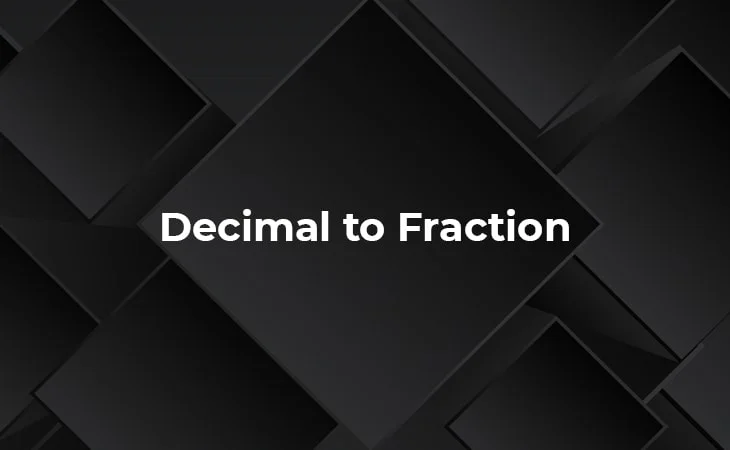Decimal to Fraction Calculator
Decimal to fraction calculator will help you to convert decimal values into fractions. It's a free and easy-to-use tool. Also, you will find the conversion chart here.
About Decimal to Fraction Calculator
From childhood, we were very interested in numbers and equations. Remember your mathematics class when you were a kid. Playing with simple numbers was easy and fun until numbers arrived with points. Yes, it's decimals! Then we moved ahead of decimal to fraction conversion. It's very interesting for someone who loves mathematics. But it's very frustrating who doesn't like mathematics. Don't worry. Our tool will help you and make your work easy and fast.

Well, first of all, let's revise some basics.
Decimal is values like 2.56, 31.03, 0.004, and so on. On the other hand, fractional values are like 1/4, 1/2, 3/8, 100/990, and so on.
Look at this example to understand the difference between decimals and fractions.
Decimal = 0.5
Fraction = 1/2
What does it mean? If we divide 1 by 2 then we get the answer 0.5. It's the easiest example to understand. But some calculations can be very complex. So, for that, you can use this converter. Even more, in this article, we will discuss how to convert decimals into fractions manually using a simple formula. So, stay tuned.
How to Convert Decimal to Fraction?
For conversion, it's important to know about units after the decimal.
Let's understand it with a simple example.
0.123
Here, 1 comes at tenths, 2 comes at hundredths, and 3 comes at thousandths.
Example 1: Find out the fraction of 0.35
The last digit is 5 that is at the hundredths place. So, we should have to multiply and divide by 100.
(0.35 * 100) / 100 = 35/100 = 7/20
So, we can say that, fraction of 0.35 is 7/20.
Let's take some more examples.
Example 2: What is the fraction of 1.5?
Here the last digit is at the tenth, therefore, we multiply 1.5 by 10 and divide by 10.
(1.5 * 10) / 10 = 15/10 = 3/2
So, the result is 3/2 and that is an improper fraction. Therefore, we can convert it into a proper fraction.
That is 11⁄2.
Example 3: Calculate the fraction of 4.125
Here the last digit is at the thousandth place therefore we multiply and divide 4.125 by 1000.
(4.125 * 1000) / 1000 = 4125/1000
After simplification and converting into a proper fraction we will get 41⁄8.
Example 4: Convert 0.625 as a fraction
0.625 = 625/1000
gcd(625,1000) = 125
0.625 = (625/125)/(1000/125) = 5/8
How to use Decimal to Fraction Calculator?
- Most importantly, this is an online calculator. Therefore, you will need a smart device with an active Internet Connection.
- Then open Decimal to Fraction Calculator in any browser like Chrome, Firefox, or Safari.
- Firstly, you can see an input boxes at top of the web page to enter decimal value.
- So, enter the decimal numbers that you want to convert into a fraction.
- After that click on "Calculate" to show a result.
- As a result, you will get the conversion result below with full formula and calculation.
Process to Convert Repeating Decimals Values into Fraction
Example of repeating decimals are 0.66666666..., 4.7628888888... The main problem is entering these numbers is that, the last digit is repeating forever.
For example, you want to find the fraction of 0.44444... So, you can enter 0.4 in the input box. Since 4 is only the digit that keeps on repeating.
How to Deal with Negative Values?
In this case, simple rule is followed.
If x = y, then –x = –y
So, to find the fraction of –1.5 just simply enter -1.5 in the input field. As a result, you will get the fraction result in negative. This function makes this tool more unique. Because you can convert both positive and negative values.
Conversion Chart
| Decimal | Fraction |
|---|---|
| 0.00001 | 1/100000 |
| 0.0001 | 1/10000 |
| 0.001 | 1/1000 |
| 0.01 | 1/100 |
| 0.08333333 | 1/12 |
| 0.09090909 | 1/11 |
| 0.1 | 1/10 |
| 0.11111111 | 1/9 |
| 0.125 | 1/8 |
| 0.14285714 | 1/7 |
| 0.16666667 | 1/6 |
| 0.2 | 1/5 |
| 0.22222222 | 2/9 |
| 0.25 | 1/4 |
| 0.28571429 | 2/7 |
| 0.3 | 3/10 |
| 0.33333333 | 1/3 |
| 0.375 | 3/8 |
| 0.4 | 2/5 |
| 0.42857143 | 3/7 |
| 0.44444444 | 4/9 |
| 0.5 | 1/2 |
| 0.55555555 | 5/9 |
| 0.57142858 | 4/7 |
| 0.6 | 3/5 |
| 0.625 | 5/8 |
| 0.66666667 | 2/3 |
| 0.7 | 7/10 |
| 0.71428571 | 5/7 |
| 0.75 | 3/4 |
| 0.77777778 | 7/9 |
| 0.8 | 4/5 |
| 0.83333333 | 5/6 |
| 0.85714286 | 6/7 |
| 0.875 | 7/8 |
| 0.88888889 | 8/9 |
| 0.9 | 9/10 |
| 1.1 | 11/10 |
| 1.2 | 6/5 |
| 1.25 | 5/4 |
| 1.3 | 13/10 |
| 1.4 | 7/5 |
| 1.5 | 3/2 |
| 1.6 | 8/5 |
| 1.7 | 17/10 |
| 1.75 | 7/4 |
| 1.8 | 9/5 |
| 1.9 | 19/10 |
| 2.5 | 5/2 |